| The design of this tour was excellent. We had time to visit all the
major historic sites around Beijing: the Great Wall, the Summer Palace
(above), the Forbidden City (below left; this is the outer
court of the Winter Palace of the Emperors). We also jostled with Chinese
humanity to take the 12-hour train ride to Manchuria (David Fisher &
Arnie Moorhouse at Beijing train station; below right). The
term "Manchuria" has been scrubbed from the 'official' Chinese lexicon.
It was named for the Man peoples that once dominated in northeast China.
Today, forced colonization by the rapidly growing and dominant Han peoples
have changed the political climate of the northeast. Note that in both
of these photos from Beijing the sky is white with smog. China is very
rapidly industrializing; new and well-built paved roads crisscross the
countryside as cities deal with L.A.-style traffic jams; and commercialism
is rampant. There really was very little indication of a recent (and even
current) Communist approach to life. |
|
|
| In China, of course, sometimes thing are not quite what it seems. The
lovely Chinese artist sketching the Great Wall (below left)
proved to be an American for San Francisco! When I complimented her on
her "good English" she said "Thank you; I'm an English teacher." And she
showed me in her sketchbook a nice drawing of Pebble Beach's lone cypress
from my next door town in Monterey!
The Great Wall at Baideling was a tourist site that had good birding
nearby. The wonderfully evocative photo of Yellow-rumped Flycatcher
(below right) was taken there by David Fisher [©
David Fisher; used with permission]. Other highlights here included
Yellow-bellied Tit, Forest Wagtail, and something called White-browed Chinese
Warbler Rhopophilus pekinensis, a bird about which almost nothing
is known. Some of us scrambled up a steep canyon to see it in the underbrush
in response to tapes; it is a big, long-tailed bird and surely a babbler
— not a warbler! [There is a very nice photo of this interesting bird on
Björn
Johansson's trip report to e. China in May 2002]. |
|
|
| The other major habitat visited near Beijing was the mountain resort
at Wulingshan in Hebei Province. We birded between 4800-5200' elevation
along a quiet paved road in lovely mixed coniferous-hardwood forests (below
left). In the warm summer days these woods were full of flowers and butterflies
(below right). |
|
|
|
|
The Wulingshan forests held a fine variety of birds including Narcissus
Flycatcher (above left), Chinese Leaf-Warbler (above center),
and Gray-sided Thrush (above right). These are all species that
have rarely been photographed, and each is interesting:
-
Narcissus Flycatcher is a male of the subspecies elisae,
an endemic breeder to east China, that probably should be considered
a separate species from nominate Ficedula narcissina of Japan.
This taxon is not often photographed although the Japanese bird has been.
We also saw several "Peking Flycatcher F. beijingnica" (Zheng et
al. 2000) which is actually the first-summer male of F. (n.) elisae.
In each case the "Peking" responded vigorously to the song of elisae
and essentially proving they are the same species. Dickinson (2003) wisely
does not consider "beijingnica" even a subspecies; he simply lumps
it with elisae stating that "critical acoustic information is missing"
from Zheng et al. (2000) and "the description might apply to a subadult
form of elisae (which is exactly the case!). Paul Holt has been
in the forefront of getting this sorted out. Unfortunately, I understand
the Clements (and those who follow his world checklist) fell for this bogus
bird hook, line, and sinker....
-
Chinese Leaf-Warbler Phylloscopus yunnanensis [=P. sichuanensis]
is a recently described species (Alström, Olsson & Colston 1992);
it is a split from the Pallas's/Lemon-rumped Warbler group. Dickinson (2003)
explains that it has recently been confirmed that a holotype of this new
species proves to be the previously described yunnanensis (as suspected
by Martens 2000), to it is yunnanensis that is the new split, with
"sichuanensis" a junior synonym. The taxon was split on its vocalizations
— it is a noisy creature at Wulingshan! Surely it has been rarely photographed
in the wild (if at all) but David Fisher and I got nice digiscopes of territorial
males singing for the tops of spruces.
-
Gray-sided Thrush Turdus feae is a breeding endemic to Hebei
Province in east China so is little known and very rarely photographed.
For all we know, the shots David Fisher & I took may be the first to
be taken in the wild. This thrush is elusive and hard to see except near
dawn when it sings from the tops of tall trees and from power lines! It
winters from Assam (India) to n. Laos, and thus is not well-known in its
winter range, either.
Other highlight birds at Wulingshan included Chinese Nuthatch (a near-endemic
to China; a few in Korea), the gorgeous but skulking Siberian Blue Robin,
Blue-and-white Flycatcher (with its vaguely Canyon Wren-like song), and
Godlewski's Bunting, common here. We heard Koklass Pheasant but did not
see it despite much effort. |
|
Our 12-hour overnight train trip from Beijing dropped us off in early
morning at the bleak factory city of Baichengzhi on the Manchurian plain.
We were met by local guides and jeeps for a two-hour further drive north
to some extensive grasslands within a military firing range. The shortgrass
prairie (below) reminded me of eastern Montana.

|
| The primary purpose of our visit was the hope to find Jankowski's
Bunting, a Chinese near-endemic now listed as Vulnerable by Birdlife
International (2000). Rather little is known about this species — sometimes
called Rufous-backed Bunting — although it was a Chinese researcher who
took us to this singing male (right), so someone is doing studies.
It is a beautiful little bunting with a prominent belly patch. Paul Holt
had missed it on recent trips to Xinghai Reserve, where it once occurred,
perhaps affected by prolonged drought there. |
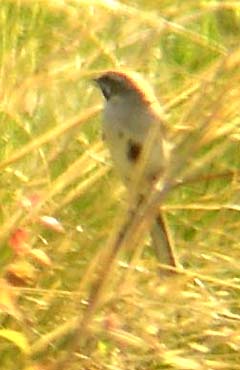
|
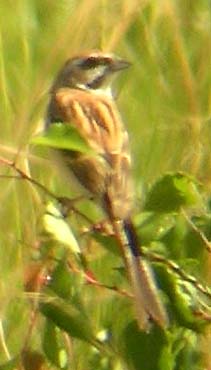
|
|
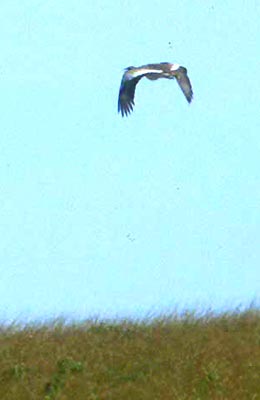
|
It was extremely pleasant to find that this grassland also hosted a
nice population of Great Bustard; we accidentally flushed one from a nest
(Great Bustard in flight; left). Speaking of nests, I happened upon
a nest of Asian Short-toed Lark (below) when I accidentally
flushed a sitting female from four eggs. This little-known species was
common in the grasslands — males were constantly up in the air doing impressive
song flights.
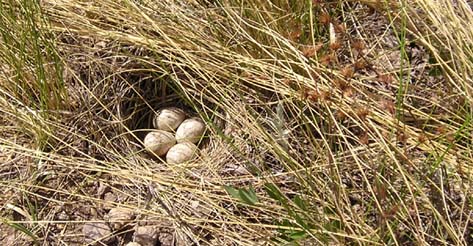
Other grassland birds included Daurian Partridge, Amur Falcon, Mongolian
Lark, and Pallas's Reed-Bunting. |
|
| The trip to Jilin Province in Manchuria was designed mostly to visit
the crane reserve at Xinghai Nature Reserve. A new guesthouse features
a crane fountain (right). As we were the first foreign visitors here, Paul
was greeted enthusiastically by the manager (below left) while the rest
of the staff (all women) clustered around David to see his digital snaps
of them (below right). |
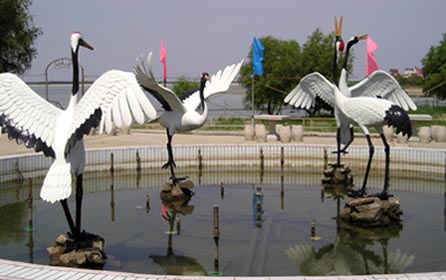
|

|

|
|

|

|
| Xinghai Reserve has suffered from a 6-7 year drought. We were able
to walk dry-footed well into the remaining marshes (above top). Here we
found Schrenck's Bittern (photo on this report's page
one) and get good comparison of a Manchurian Reed-Warbler among many
Black-browed Reed-Warblers. But it took hours of searching to find the
two rare cranes. Our first Red-crowned Crane (in flight, just above)
and even later views were moderately distant (below left). I have a separate
page on the Cranes
of north China with another Red-crowned photo plus one of
White-naped Crane. Another lifer for me on the reserve was Gray-headed
Plover (below right); other birds of note included Chinese Penduline-Tit,
Chinese Gray Shrike, and Swan Goose. |
|
|
The links below include many more photographs:
PHOTOS: All photos on this page are © 2004 Don Roberson
except the Yellow-rumped Flycatcher © 2004 David Fisher and used with
permission; all rights reserved. Many other shots from this trip are scattered
about this web site. Check particularly bird families, mammals, and herps
listings.
|
Literature cited:
Alström, P., U. Olsson, and P.R. Colston. 1992. A new
species of Phylloscopus warbler from central China. Ibis 134: 329-334.
Alström, P., U. Olsson, and P.R. Colston. 1997. Re-evaluation of
the taxonomic status of Phylloscopus proregulus kansuensis. Bull.
Brit. Orn. Club 117: 177-193.
Birdlife International. 2000. Threatened Birds of the World. Lynx Edicions,
Barcelona, Spain.
Dickinson, E.C., ed. 2003. The Howard & Moore Complete Checklist
of the Birds of the World. 3rd ed. Princeton Univ. Press, Princeton, N.J.
MacKinnon, J., and K. Phillipps. 2000. A Field Guide to the Birds of
China. Oxford Univ. Press, Oxford.
Zheng, G., Song, Zhang, Zhang, and Guo. 2000. A new species of flycatcher
(Ficedula) from China. J. Beijing Normal Univ. (Nat. Sci.) 36 (3):
405-409.
|




